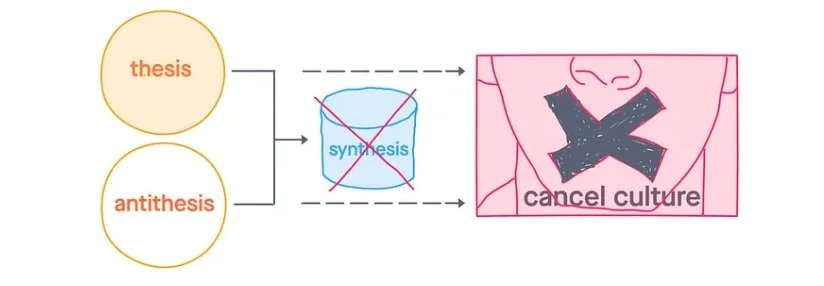UX Collective articles (English)
The storytelling war: there is no consensus possible in the culture of cancellation
Why do we need to design a new paradigm to promote collective agreements?
The first presidential debate between Joe Biden and Donald Trump was a pathetic political show. It was riddled with insults and interruptions. Trump interrupted Biden about 145 times, and Biden cut off Trump about 67 times, according to the Fox News report. In their second showdown, the politicians tried hard not to interrupt each other, to avoid chaos. But in essence, there was no debate. They were parallel monologues — soliloquies on a theme proposed by the moderator that avoided crossfire between the candidates. Trump and Biden represent the destructive discursive forms of the time. They symbolized the political debate and the social debate. In the storytelling war, in the social and collective conversation, on the Internet, on social media, and especially on Twitter, there is no consensus possible in the culture of cancellation.
“Twitter is like the door to a public toilet”
— Jorge Lanata.
The definition by journalist Jorge Lanata is very accurate. On Twitter, a cruel and ruthless war is being waged, irrefutable proof of public bullying and the cult of ‘discrepancy.’ As in a boxing ring, with low blows, a tense and aggressive atmosphere is generated. ‘You are canceled, or I’ve blocked you,’ we read, daily, in tweets from well-known political or professional users. Isn’t it a bit histrionic? The discussions are lost in personal criticism, instead of questioning the logic of the other.
In the storytelling war, dialectic does not matter.
What counts is the disqualification. It is a strange war where we all lose because the essence of dialectics is not to win but to reach an agreement. Debates become sterile because there is no dialectic possible in the cancel culture.
What is dialectics?
Dialectics is essentially a conversational technique, a method of antagonistic dialogue between two opposites. The history of dialectics dates back to antiquity, to the time of Heraclitus (450 B.C.). In modern times, the German philosopher Friedrich Hegel explained the dialectical process as representing philosophical idealism. It is the logical basis for the evolution of ideas: a concept faces its opposite, and a third results from the conflict — the synthesis:
Friedrich Hegel, philosopher of German Idealism (1770–1831)
We use dialectics as a method of thought every day. It explains our tendency to categorize, to search for archetypes, and “to see everything in black and white.” We are used to receiving “processed” information from the outside that, from childhood, simplifies reality for us to facilitate our understanding. They draw an antagonistic world for us, and we absorb the knowledge without relativizing the information, losing the observer’s perspective. We have a passive and antagonistic look: east or west, good or bad, hero or villain. While science and technology have discovered other dimensions, people still use binary logic in human ideas. Humans think and reflect just as they did hundreds of years ago.
But the dialectic no longer holds in digital communication; it becomes chaotic. Only a few years ago, information was in the power of an elite that transmitted it to the masses through mass communications. There was a specific control over the world’s storytelling. Now, this is unworkable. Perhaps this informational chaos explains the difficulty in generating consensus, new ideas, and new syntheses. Without a new organization in the discourse, no dialectic dialogue or agreement is possible. In this dynamic of eternal confrontation, a distorted form of dialectics, positions are radicalized and transformed into ideological axioms. It is a sick dialectic that generates dogmas. We do not tolerate the opinion of the other because there is no dialectic possible in the new current diagram of communication:
New diagram of communication in the culture of cancellation
In the storytelling war, the conflict is aggravated when it passes to collective organizations. Some public opinion issues provoke the PRO and the ANTI’s appearances: We do not find truce nor peaceful coexistence in the diversity of thought. Some minority or majority movements become totalitarian: You are either for or against, the discussion on abortion, the radicalization of the feminist movements, quarantine, and vaccines.
The opinions of the center are mediocre because they do not become viralized in the collective imagination.
There is no place for the lukewarm on the Internet. Moderates do not thrive on political debate. There is no ‘middle way’ in the dialectic logic of the culture of cancellation.
Dialectic is functional to political power
We need a paradigm shift to replace the dialectic. The different dimensions and perspectives are already within reach of individual people. We no longer live in isolation in a village; we know the differences in other people’s criteria, time, and space. But why is it so difficult to consider the circumstance of the other? From my perspective, the distorted dialectic is functional to the nuclei of power because the mass is manageable, much more so than a group of individuals with their own will and decision. Thus, an ideology is decreed that dictates the behavior of its members. It demands loyalty from them and suspends their individual faculties of thought. It prevents them from changing their minds, promotes ideological tradition, and provokes clientelism. For this reason, idealization has become anachronistic because it no longer allows us to evolve.
“Il n’y a que les imbeciles qui ne change pas d’avis.”
— French proverb.
But to think always ‘the same’ is dangerous. The same idea repeated over and over in your head makes a groove in your brain. Justifies your opinion by adapting any external information that confirms your solid arguments. It makes it into axioms and adheres to dogma.
On the day of Peronist Loyalty, a website was created that collapsed and went down. Those responsible for the site blamed a ‘massive attack’ by computer hackers. The accusation was not proven.
OnOctober 17, Argentina celebrated Peronist Loyalty Day: ‘We were born out of love for Perón and Evita,’ emphasized President Alberto Fernández, referring to the birth of the movement more than 70 years ago. Love for a leader, loyalty to a party, which also has the name of a person, — the values and beliefs of ideologies are born through leadership in a particular time and space. The leader summons, convinces, and preaches his ideas, recognized by a majority collective, in a time and space. Thus, an ideology is created, functional in a particular moment and circumstance. But when ideology is perpetuated in time and sustained by a group of fans, we face a dogma. A fan worships the leader as a god and is incapable of analyzing those ideas as an observer in space and time.
Indoctrination reaches even school-age children:
Books to be published for the Argentine public school in 2019. Populismo y Educación
El caso peronista
Indoctrination in children. October 26th, 2020: A child with a Peronist speech the day of the march when it was 10 years since the death of Nestor Kirchner (2011).
And so we will be free: the design of a new paradigm
On the other hand, when people analyze the ideas from their own perspective without prejudice, they will be immune to indoctrination. They have a changing way of believing that responds, with freedom, to their personal and social circumstances. They consider the information in all its dimensions of time and space. There is not just east or west; there is also north and south, and a dimension of time that conditions and determines all the others. When someone says, ‘I am a socialist,’ what socialism is this person talking about? I mean that there are people who define themselves according to anachronistic ideas that no longer correspond to their reality. These people have lost their perspective.
“The doctrine of dialectics is pure and solidified knowledge, incapable of correction; that is why it has been transformed into dogma”
Jerson Devitt, Critique of Dialectical Reason –Jean-Paul Sartre.
In his existentialism, Sartre criticized Hegel and Marx for their systemic thinking, for not understanding individual existence, and for not explaining many phenomena. People’s subjectivity must face objective situations — such as pandemics, economic crises, or social crises — which must influence their reason and logic beyond their ideologies. Thus, they will be free.
“Space and time are objectives, and it is there that man develops, realizes himself, and is free. These objective situations have to be faced by the human being, and it is there where man becomes a man”
Jerson Devitt, Critique of Dialectical Reason –Jean-Paul Sartre.
But Sartre was advanced for his time; he was not adequately understood by his contemporaries. In my opinion, existentialism could be the theoretical basis of this new paradigm. It could be more in line with this multidimensional and diversified era, with an inter-personal perspective that considers and respects other people’s views, the groups’ sight, and knows how to create agreements in that context. This is good because we are programmed to understand dialectical logical thinking, and the new reality escapes that binary logic. Thus, we will be free of ideologies, and we will generate a collective consensus in this new chaotic and polarized normality.
Creating the new paradigm: the multi-dimensional thinking
Let’s start by abandoning the antagonistic view in the construction of the social or geopolitical story. Its “ lens “ does not reach the collective panorama; it does not reflect reality. Let us maintain ideologies at an inter-personal level of relationship, assuming their dogmatic interference in society. Let us value social or political institutions for their ideological orientation, but let us question their actions by observing their results in personal and collective experiences.
Secondly, let us make an effort to eliminate prejudices and low passions in public debates. Let us weaken the story of the villainous hero from childhood. We will value the individual for his personal qualities and not for being a member of a group. Let us discredit racist movements or any movement that considers the person for his condition of belonging and not for his individual value.
Thirdly, and already thinking about the method, the new paradigm would be directly related to design as a discipline and its research methods. I am talking about methodologies such as Human-centred design or Design Thinking that could work to construct the political and social narrative. HCD as a framework that considers human perspectives throughout the design process, or design thinking as a process that empathizes, defines, ideas, makes prototypes and tests.
These methods are the practical application of Sartre’s existentialism. A look centered on each observer-researcher who takes the facts and circumstances according to their perspective. That focuses on people, on how they feel, on what they experience at a time and place, regardless of their origin or group of belonging. And they formulate a proposal as a possible solution. But that is never an absolute truth. A designer may prefer a specific method or tool, but their only real commitment is to the user.
The designer will have the function of organizing this chaos in the storytelling, teaching the method of thought to be applied in multidisciplinary groups of professionals, some with an ideological tradition. Nothing would be black or white, lie or truth, and less eternal or infinite. Tolerance and diversity would go hand in hand with resilience, and the focus would be on the problem without falling in love with the solution.
Finally, a diagram of the new paradigm will help this reflection. I propose is a 3-dimensional diagram, close to the vision of Design thinking and the semiotic vision submitted by Charles Sanders Peirce (Peirce’s Theory of Signs: icon, Objet, symbol). Any other suggestions?
A possible paradigm for multi-dimensional thinking







